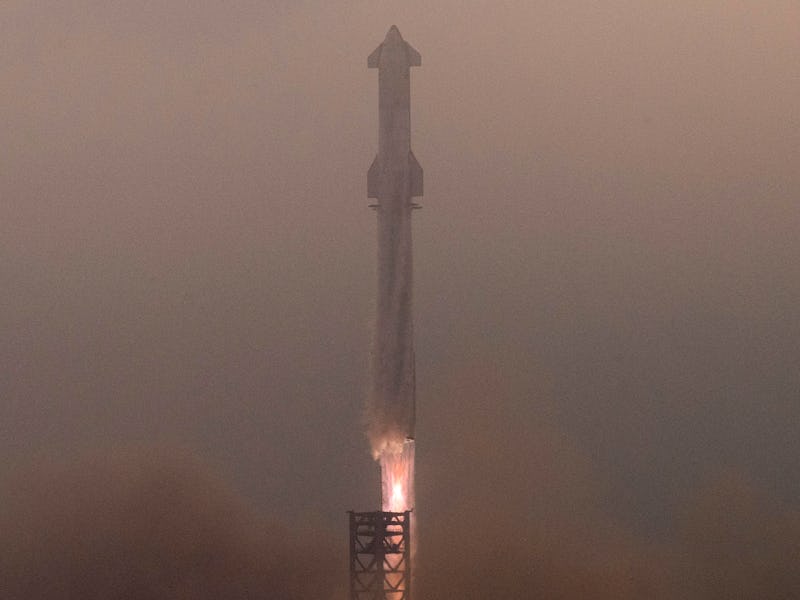NASA Needs SpaceX’s Starship to Work — Here’s the Critical Reason Why
It's Not Just About Artemis 3, there's also an important side quest.

Starship’s fourth test flight launched at 8:50 am Eastern Time today, and both SpaceX and NASA are declaring the flight, which included splashdown of the Super Heavy first stage, plus re-entry and splashdown for Starship itself, a success.
Flights of the world’s largest rocket are starting to seem almost routine this spring, but SpaceX is under tremendous pressure to have Starship ready to fly the Artemis 3 crew to the Moon — and land there — by late 2026. Starship’s test flights are also part of the key to making sure potential future missions to the Moon and Mars don’t run out of gas on the way. As SpaceX put it in a tweet shortly before launch, “The payload for these flights is data.”
The SpaceX Starship launches on its fourth flight test from Starbase in Boca Chica, Texas, on June 6, 2024. The Starship is vital to NASA's plans for landing astronauts on the Moon later this decade, and to SpaceX CEO Elon Musk's hopes of eventually colonizing Mars. (Photo by Chandan KHANNA / AFP) (Photo by CHANDAN KHANNA/AFP via Getty Images)
An Extremely Cool Engineering Challenge
The largest rocket ever flown, Super Heavy uses a combination of liquid oxygen and methane to get off the ground. Despite the exhaust blasting out the back end of the rocket at several thousand degrees Fahrenheit, the propellant in Super Heavy’s tanks has to be kept at a chilly -300 degrees Fahrenheit; any warmer, and it will boil away into gas, useless for fueling those 33 Raptor engines. SpaceX is one of several contractors — including Eta Space, Lockheed Martin, and United Launch Alliance — whose flights will gather data for NASA’s study of how to manage propellants like these on long flights.
On its third test flight (also known as the first one in which Starship made it to orbit), engineers moved propellant from the header tanks to the main tanks while the ship was coasting in orbit. That's going to be an important step for the Artemis III and IV missions to get the spacecraft out of Low Earth Orbit and on their way to the Moon. Engineers are also using these test flights to study how all those bouncing blobs of rocket fuel affect Starship’s stability in orbit.
Rockets have used super-cold, or cryogenic, liquid propellants, for decades. The Apollo missions traveled to the Moon on a mix of liquid oxygen and liquid hydrogen, both cryogenic (after using liquid kerosene and liquid oxygen to get to space). They work well, but they can be tricky, especially in space, where the temperature can swing from bitter cold to boiling hot in a matter of hours — and the way liquid floats around in microgravity means it’s difficult to transfer fuel from a storage tank to a thruster, or even measure how much is left in the tank.
And if NASA wants to realize its ambitions on the Moon, and eventually Mars, the agency and its contractors will need to store and transfer more cryogenic propellant, for longer flights, than ever before.
“Storing and transferring cryogenic propellant in orbit has never been attempted on this scale before,” said Jeremy Kenny, project manager, NASA’s Cryogenic Fluid Management Portfolio at Marshall, in a March 2024 statement.
That’s where SpaceX comes in, along with a few of its competitors. Starship is working on a particular piece of the problem, called slosh. Once Starship’s main engines cut off, there’s no acceleration forcing the propellant to sit neatly at one end of its tank, where it’s easy to measure. Instead, you get a bunch of little blobs of super-cold fluid bouncing around in the tank. If there’s not enough pressure to keep the propellant all together, then the engine may end up pulling in a bunch of gas, rather than propellant, which means it won’t fire.
One way Starship deals with this problem is by using header tanks: a pair of smaller propellant tanks that can keep the propellant under enough pressure that it doesn't have room to slosh. The header tanks provide the initial sip of propellant the engines need to restart in orbit. Once the engines restart, their thrust will push the liquid in the main tanks back into the right position to flow to the engines and keep them firing.